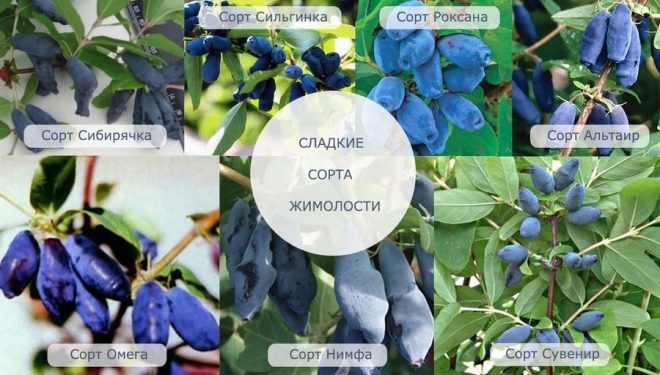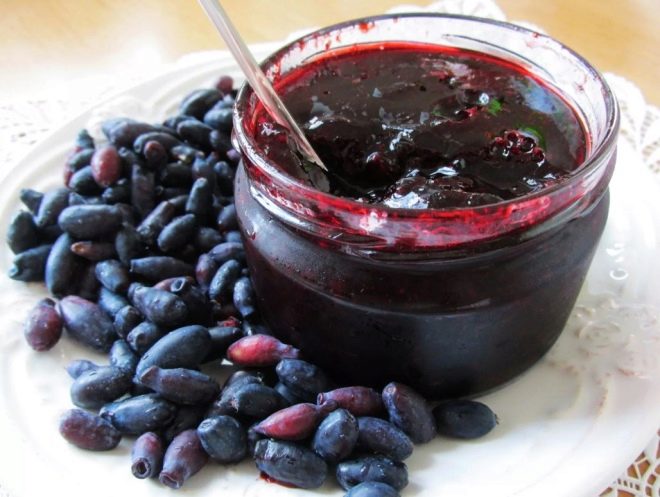At what age can honeysuckle be given to children?
Honeysuckle berries are a good alternative to pharmaceutical drugs for a variety of diseases. In addition, they are tasty by themselves. In this article we will tell you whether babies are allowed to eat honeysuckle and dishes from it and from what age you can give it to babies.
About the product
Honeysuckle - berry shrub, which grows mainly in Southeast Asia, which is their historic homeland. But the efforts of modern breeders were not in vain, and varieties have already been created for the north of Russia, for its southern and central regions. For an unusual type of shrub gardeners appreciate, and therefore today honeysuckle on the site is not uncommon, and the berries on the table are not exotic.
The berries contain a lot of minerals - such as calcium and potassium, magnesium, iron, copper and phosphorus, as well as iodine and vitamins A, C and B.
The elongated, velvety blue berries draw the attention of the child. The length of the berries of some varieties can reach 10-11 centimeters.
But not every honeysuckle is suitable for baby food and for human consumption as a whole. You can collect and use in the kitchen for its intended purpose. only fruits of edible shrubs.
Benefit and harm
The beneficial properties of honeysuckle for the body of the child are numerous and multifaceted.
Berries, rich in vitamin C, are recommended during colds, viral infections occurring against the background of high temperature. It is believed that honeysuckle helps reduce heat, strengthen the immune system. The berry is also attributed a moderate diuretic effect.
Honeysuckle strengthens the walls of blood vessels, improves blood circulation, helps normalize the work of the stomach and intestines, and has a beneficial effect on metabolic processes. In diseases of the liver and gallbladder, honeysuckle is recommended especially.
For skin ailments, infusions of leaves and branches of honeysuckle are used topically, and decoctions of them will be useful for gargling during sore throat. Berry juice is considered a strong antioxidant.
Contraindications are few and mainly concern the amount. If you eat too much honeysuckle, a sharp increase in the number of red blood cells in the blood is not excluded, which is also not beneficial, and digestive disorders may also appear. Berry rarely causes allergies, but this possibility is not excluded at all. Therefore, children give fruit with great care.
Age restrictions
No matter how useful the honeysuckle may be, earlier than 7 months old, it is not recommended to introduce it into complementary foods for young children. Initial doses should be minimal - no more than a third of a teaspoon of grated berries.
If the baby suffers from atopic dermatitis or has a tendency to allergies, then the baby should be delayed with honeysuckle for at least one year. A one-year-old child begins to be given supplements with an amount not exceeding half a teaspoon per reception.
At 2-3 years old, a child can easily eat about 100 grams of honeysuckle at a time, but this amount should be taken gradually, increasing the amount of food eaten in stages. At any age, the occurrence of a eating disorder, diarrhea, skin rashes after eating berries is an indication for the immediate elimination of honeysuckle from the diet and a return to this prikorm in a few months, because children tend to "outgrow" their allergies.
For infants honeysuckle can be an excellent source of vitamins, but it should be given only with the permission of the pediatrician. In 1 year, parents can make a decision about the introduction of honeysuckle in the diet.
In what form to give the child?
As a first meal it is better to give berries in the form of mashed potatoes. It can be prepared using a blender, it is not difficult, because the berries are soft and do not have seeds. Do not add sugar, for the first meal sweet mash is not suitable.
Honeysuckle berries rubbed with sugar can be harvested for the winter. They can be added to tea for the child, make juice. From fresh berries can be cooked compote - the taste is a bit unusual, but very pleasant.
In the winter you can dry the fruit. Then they can make decoctions for colds, add to tea with diarrhea, prepare water infusions for gargling and mouth rinsing.
An excellent storage option for the winter will be freezing. Thawed berries can be used to make fruit drinks, add to pastries and cook compotes in the winter when there is a shortage of vitamins in food.
Honeysuckle is added to the curd mass, pastries and homemade soufflé. Juice is squeezed out of it, which can also be given to a child. Large elongated berries make excellent jams and jellies, but they are given to children in limited quantities due to their high sugar content.
Reviews
According to reviews of moms, as the first berry, honeysuckle is perfect for a baby. Of all the berries, which theoretically can be introduced into the supplements after six months, it is honeysuckle that causes allergic reactions less often than others. Not all children immediately perceive the taste of this berry with delight, but they gradually get used to it, and already in 3-4 years they pick fruits from the bush at the site and eat with pleasure.
You will learn more about honeysuckle by watching the following video.
































































